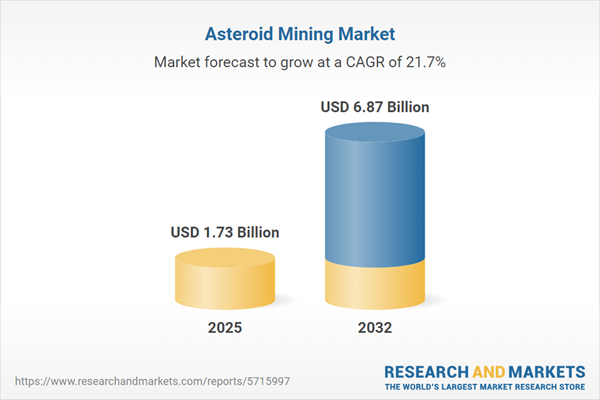Speak directly to the analyst to clarify any post sales queries you may have.
The asteroid mining market is shifting from theoretical exploration to actionable commercial development, as senior executives confront new challenges and opportunities shaped by technology advancements and evolving regulations. Decision-makers now actively reconsider how best to position their organizations for sustained competitiveness as the sector emerges on the global stage.
Market Snapshot: Asteroid Mining Market Overview
The asteroid mining market is valued at USD 1.42 billion in 2024, projected to reach USD 1.73 billion in 2025 and USD 6.87 billion by 2032. Growth is anticipated at a robust CAGR of 21.70%. This expansion is underpinned by sustained investment, industry partnerships, and consistent technical progress across propulsion, robotics, and in-situ extraction. Organizations responding to volatile commodity markets are optimizing procurement strategies, sourcing approaches, and regulatory compliance to drive collaboration and increase operational reach in both established and new regions.
Scope & Segmentation: Executive Insights for the Asteroid Mining Market
This report is designed for leaders aiming to navigate the complex structure of the asteroid mining sector. It provides a focused lens on operational segments, regional opportunities, and the technologies redefining value creation across the industry.
- Resource Types: Opportunities include Helium-3 for advanced energy solutions; precious metals such as gold and platinum group elements in manufacturing; rare earth elements supporting next-generation production needs; and water resources critical for in-space missions and terrestrial supply chains.
- Mission Stages: Market analysis covers extraction using advanced retrieval systems; material processing and refining functions; and prospecting strategies to select optimal assets for mission planning.
- End Markets: Value creation is found in industrial exports from ground-based operations and key in-space applications for construction, life-support, and propulsion across aerospace, energy, and manufacturing sectors.
- Technologies: The sector leverages autonomous robotics, AI-driven drones, teleoperated systems, and human-crewed missions. These innovations enable the shift from exploration to scalable operational activities.
- Geographic Regions: Regional dynamics vary with the Americas—particularly the United States, Canada, and Brazil—playing active roles; Europe, Middle East & Africa—including the UK, Germany, Russia, and South Africa—offering unique regulatory landscapes; and Asia-Pacific—focused on China, India, Japan, and Australia—addressing market growth through local adaptation strategies.
- Key Players: Influential companies like ispace Inc., AstroForge, OffWorld Inc., Shackleton Energy, TransAstra Corporation, Deep Space Industries, Planetary Resources, Effective Space Solutions, Asteroid Mining Corporation, and Origin Space Technology foster innovation and industry collaboration across all regions.
Key Takeaways for Senior Decision Makers
- Incremental advancements in propulsion and robotic capabilities are strengthening operational resilience, optimizing supply chain reliability across challenging asteroid environments.
- Public-private collaboration is accelerating infrastructure development and fostering sharing of sector knowledge, promoting adaptable and efficient development models.
- Recent regulatory reforms are enabling wider industry participation, lowering barriers for both established organizations and market entrants.
- Consortium-based structures and integrated value chains are emerging as effective risk-balancing mechanisms, supporting continuous innovation across all operation phases.
- Firms are focusing on technology-enabled solutions that support seamless operations across in-space and terrestrial settings, enhancing mission reliability and project continuity.
Tariff Impact: Navigating U.S. Regulatory Shifts in 2025
U.S. tariffs affecting orbital mission equipment and asteroid capture systems are driving changes in sector cost structures. In response, procurement leaders are diversifying suppliers, establishing cross-border partnerships, and prioritizing risk management in global supply chains. Close collaboration with space agencies and proactive regulatory planning are becoming essential to maintain competitiveness and operational efficiency across regions.
Methodology & Data Sources
The research adopts a triangulated approach, integrating insights from mission engineers, procurement specialists, and regulators. Using peer-reviewed studies, operational records, and scenario-based modeling, the analysis supports actionable recommendations and robust risk assessment for strategic planning.
Why This Asteroid Mining Market Report Matters
- Enables leadership teams to shape pilot project development, implement targeted technology adoption strategies, and anticipate policy trends in the rapidly evolving asteroid mining environment.
- Delivers rigorous market segmentation, competitive analysis, and region-specific intelligence based on quantitative data and scenario modeling for effective planning and informed investment.
- Equips organizations to identify emerging trends, pivot strategies as required, and maintain long-term agility in resource allocation and decision-making processes.
Conclusion
Asteroid mining is advancing toward commercial scale. Leaders who proactively address regulatory shifts and implement flexible strategies will be best positioned to capitalize on new market openings and drive sustainable organizational growth.
Additional Product Information:
- Purchase of this report includes 1 year online access with quarterly updates.
- This report can be updated on request. Please contact our Customer Experience team using the Ask a Question widget on our website.
Table of Contents
3. Executive Summary
4. Market Overview
7. Cumulative Impact of Artificial Intelligence 2025
Companies Mentioned
The companies profiled in this Asteroid Mining market report include:- ispace Inc.
- AstroForge, Inc.
- OffWorld, Inc.
- Shackleton Energy Company LLC
- TransAstra Corporation
- Deep Space Industries LLC
- Planetary Resources LLC
- Effective Space Solutions Ltd.
- Asteroid Mining Corporation
- Origin Space Technology Limited
Table Information
| Report Attribute | Details |
|---|---|
| No. of Pages | 198 |
| Published | October 2025 |
| Forecast Period | 2025 - 2032 |
| Estimated Market Value ( USD | $ 1.73 Billion |
| Forecasted Market Value ( USD | $ 6.87 Billion |
| Compound Annual Growth Rate | 21.7% |
| Regions Covered | Global |
| No. of Companies Mentioned | 11 |








